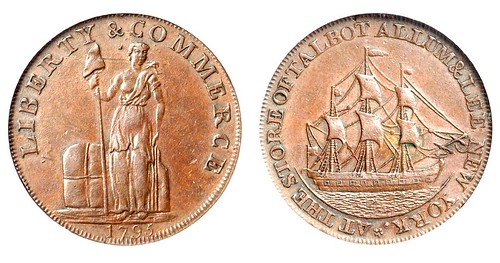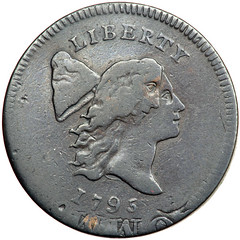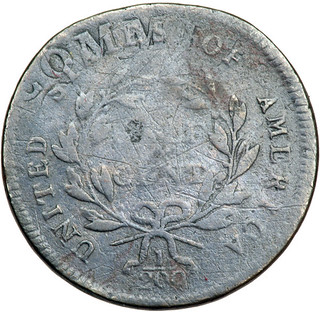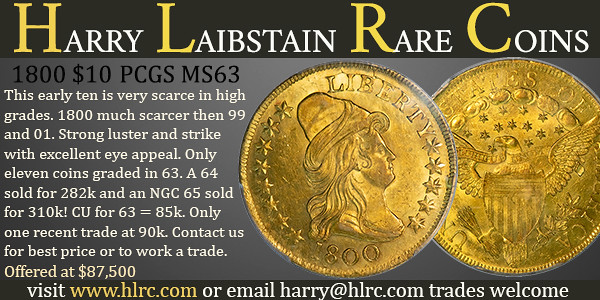
PREV ARTICLE
NEXT ARTICLE
FULL ISSUE
PREV FULL ISSUE
HALF CENTS STRUCK ON TALBOT, ALLUM & LEE TOKENSOn September 9, 2020 Dave Bowers published this Mint News Blog article on a hoard of Talbot, Allum & Lee coppers and their repurposing as planchets for U.S. half cents. -Editor

At 241 Water Street in lower New York City, the firm of Talbot, Allum & Lee engaged in the India trade, importing goods by ship. Formed in 1794, the partnership operated only until 1796. Principals included William Talbot, William Allum, and James Lee. This particular district of the city was a beehive of activity with vessels continually arriving and departing. Numerous ships' chandlers, grog houses, cheap lodging places, and other establishments for the convenience of sailors did a lively business. Copper tokens dated 1794 and 1795 bearing the image of the standing goddess of Commerce on the obverse and a fully-rigged sailing ship on the reverse were struck to the order of Talbot, Allum & Lee by Peter Kempson & Co., Birmingham, England, and imported into America by the partners. The quantity has been estimated at over 200,000 coins, but no original records have been located. At the time, copper coins in circulation in New York and nearby areas were a curious assortment of issues made by or for various states (Connecticut, Massachusetts, New Jersey, New York, and Vermont), British halfpence, counterfeits, and other pieces. The Liberty Head copper cents made at the Philadelphia Mint beginning in March 1793 were not particularly numerous. Generally, just about any copper coin the size of a British halfpenny (about the same size as an American cent) would trade in commerce at the value of one cent. It was popular speculation and, at the same time, a worthwhile advertising scheme to have copper tokens privately struck for a cost of less than a cent apiece, and pay them out at one cent. In accordance with this practice, Talbot, Allum & Lee tokens dated 1794 were put into circulation where they served at the value of one cent in local and regional commerce. Pieces dated 1795 seem to have been less popular. Apparently, undistributed tokens piled up at the waterfront store. What should be done with the hoard? The answer came quickly. On April 23, 1795, the firm sold 1,076 pounds of the tokens to the Philadelphia Mint for 18¢ per pound, or $193.68. On December 10, 1796, the remainder of the token stock amounting to 1,914 pounds of copper was purchased by the Mint from William Talbot for $319, or 16.6¢ per pound. These tokens weighed in at about 46 to 50 to the pound, equivalent to around 140,000 to 150,000 pieces acquired in the Mint's two purchases. The coins were a godsend to the Mint, which had been experiencing severe difficulties obtaining copper stock from which to strike half cents and cents. Supplies of this metal were erratic and of uncertain quality and included such varied sources as copper sheet for roofing and the protection of ships' hulls, and old pots and kettles. Planchets for United States half cents were cut by punching discs from the Talbot, Allum & Lee tokens, most of which were probably in mint condition. Today it is not unusual to find a 1795 or 1797 U.S. half cent (but not one dated 1796) with faint traces remaining of the token undertype — usually some of the ship's rigging and/or some of the letters around the border of the token. Such half cents are highly prized by numismatists as they are literally two coins in one.
I reached out to Half Cent expert Bill Eckberg who kindly pointed me to images from the Davy collection at Goldbergs showing various traces of the undertype. Thanks! Here's Lot 41, a 1795 Half Cent double struck over a 1794 Talbot Allum & Lee Cent. On the obverse below the date are signs of the letters "OMM" in "COMMERCE" and more lettering on on the reverse -Editor



Regarding Lot 70, Bill writes: "This one is best of the three. Plenty of lettering visible. Usually, all you see is bits of ship rigging. Lot 34 has undertype from the ship's rigging below the left side of the date. Lot 41 has lots of undertype from ship rigging and lettering on the reverse."


Lot 70, a 1797 Half Cent struck on a 1794 Talbot Allum & Lee Cent
To read the complete lot descriptions, see:
To read the complete article, see:

Wayne Homren, Editor The Numismatic Bibliomania Society is a non-profit organization promoting numismatic literature. See our web site at coinbooks.org. To submit items for publication in The E-Sylum, write to the Editor at this address: whomren@gmail.com To subscribe go to: https://my.binhost.com/lists/listinfo/esylum All Rights Reserved. NBS Home Page Contact the NBS webmaster 
|